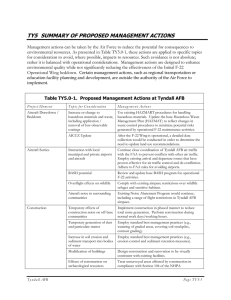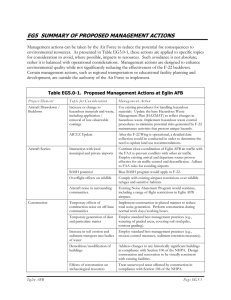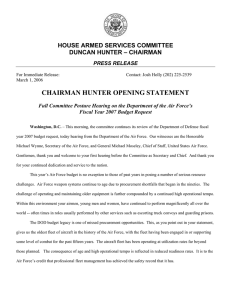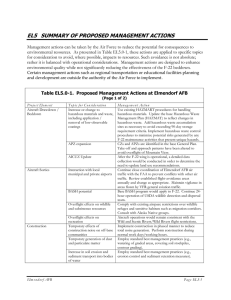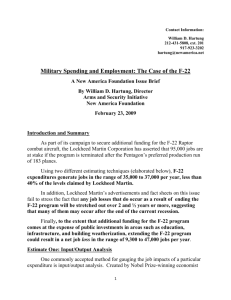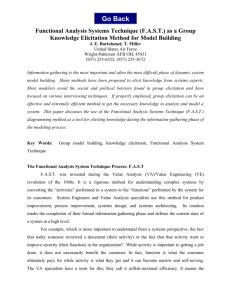GAO TACTICAL AIRCRAFT Restructuring of the Air Force F-22 Fighter
advertisement
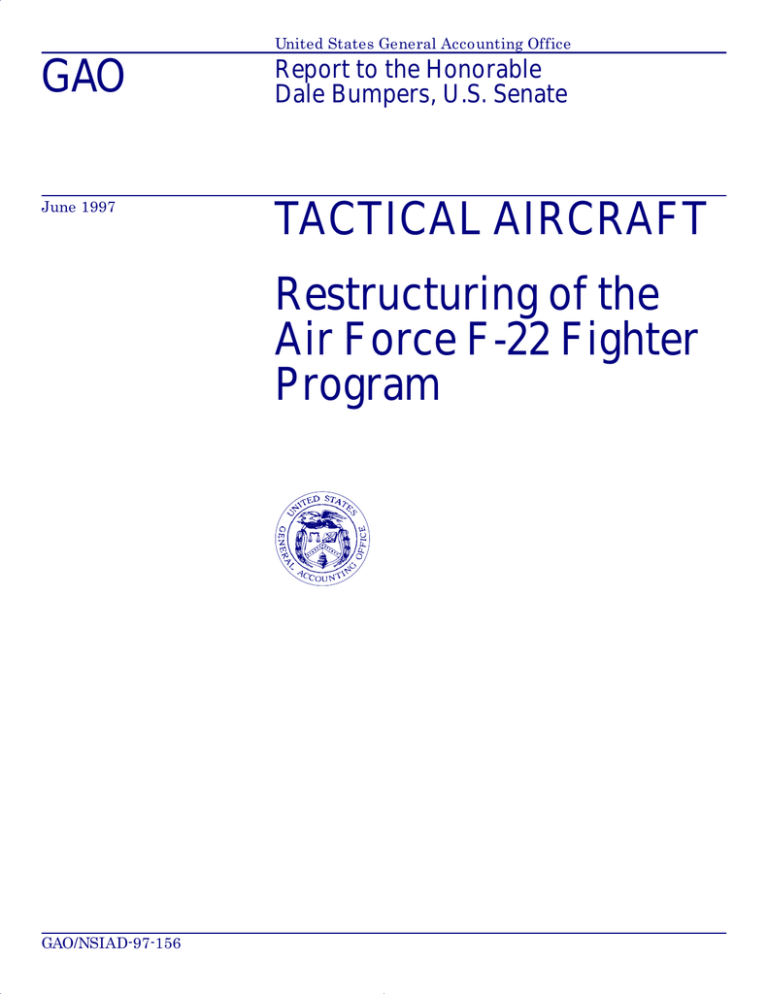
United States General Accounting Office GAO Report to the Honorable Dale Bumpers, U.S. Senate June 1997 TACTICAL AIRCRAFT Restructuring of the Air Force F-22 Fighter Program GAO/NSIAD-97-156 GAO United States General Accounting Office Washington, D.C. 20548 National Security and International Affairs Division B-276815 June 4, 1997 The Honorable Dale Bumpers United States Senate Dear Senator Bumpers: In response to your request of February 24, 1997, we reviewed the Air Force’s February 1997 plans to restructure the F-22 program. This report presents our observations regarding the estimated cost of the restructured program and viability of cost reduction initiatives, planned timing for realization of benefits from initiatives, and criteria for approving initiation and continuation of production. An important factor that will significantly impact the cost of the restructured program, and the viability of cost reduction initiatives discussed in this report is the Quadrennial Defense Review, which was released in mid-May. This review calls for reductions in the F-22 low-rate initial production (LRIP) quantity, the total production quantity, and the production rates. Because the production quantities and rates were basic assumptions guiding the February 1997 F-22 restructuring plan, changes in the F-22 program that result from the review will require reevaluation of the cost of the program, the potential for cost reductions, and the contract strategy. Nevertheless, the information in this report provides an important historical and contextual framework for decisionmakers as they debate the issues surrounding the F-22. Background The F-22 is an air superiority aircraft with a capability to deliver air-to-ground weapons. Advanced technology being developed for the F-22 makes it “. . . a very ambitious, challenging program, probably the most challenging program in recent times,” according to the Department of Defense’s (DOD) Defense Science Board. The most significant features include supercruise, the ability to fly efficiently at supersonic speeds without using fuel-consuming afterburners; low observability to adversary systems that have the objective of locating and shooting the F-22; and integrated avionics to significantly improve the pilot’s battlefield awareness. The F-22 program began the engineering and manufacturing development phase of the acquisition process in 1991. According to the fiscal year 1997 President’s budget, the Air Force planned to develop the F-22 and build Page 1 GAO/NSIAD-97-156 F-22 Restructuring B-276815 nine development aircraft, two nonflying structural test articles, and four preproduction aircraft at a cost of about $17.4 billion. The Air Force planned to buy 76 aircraft during the LRIP phase of the program and 362 aircraft during the full-rate production phase. The total estimated production cost was about $48 billion. The Assistant Secretary of the Air Force for Acquisition engaged a Joint Estimate Team (JET) because management reviews of the F-22 program indicated potential cost growth. In February 1997, the Under Secretary of Defense for Acquisition and Technology approved the Air Force’s proposed plan to restructure the F-22 program based on the results of the JET’s review. JET concluded that the F-22 engineering and manufacturing development program would require additional time and funding to reduce risk before the F-22 enters production. JET estimated that the development cost would increase by about $1.45 billion.1 Also, JET concluded that F-22 production cost could grow by about $13 billion (from $48 billion to $61 billion) unless offset by various cost avoidance actions, identified as tier I and tier II initiatives. These initiatives are being further defined by a study team chartered by the Assistant Secretary of the Air Force for Acquisition. That team is scheduled to report its conclusions in the fall of 1997. We have not reviewed the basis for the revised savings estimates that are now being devised by the team. We have issued a number of reports concerning the F-22 fighter program. (See Related GAO Products at the end of this report.) In an April 1995 report,2 we recommended that the Secretary of Defense reduce the degree of concurrency between development and production of the F-22 and minimize commitments to production until after successful completion of operational testing. Results in Brief Our reviews of various weapon system acquisitions have shown that initial program schedules and cost estimates have historically been optimistic and have not often been achieved. The F-22 program is not an exception. Further, we believe the February 1997 restructuring plan reflects revised cost goals that may be optimistic because (1) the planned reductions in F-22 production unit costs are greater than those experienced by prior 1 JET estimated the increase at $2.2 billion; however, a decision to delete preproduction aircraft, estimated to cost $706 million, reduced the estimated development cost increase to $1.45 billion. 2 Tactical Aircraft: Concurrency in Development and Production of F-22 Aircraft Should Be Reduced (GAO/NSIAD-95-59, Apr. 19, 1995). Page 2 GAO/NSIAD-97-156 F-22 Restructuring B-276815 fighter programs and (2) actions intended to reduce production costs have not been fully defined and validated. Our comparison of the projected reduction in F-22 production unit costs with the historical unit costs of the F-15, F-16, and F-18 programs indicates that the F-22 reductions exceed those that have been achieved on these other programs. Also, to achieve the overall cost avoidance projected by the Joint Estimate Team, the unit cost of full-rate aircraft must be reduced by 54 percent from the unit cost of the low-rate initial production aircraft instead of by 27.9 percent, as projected before the program restructure. Further, although the Air Force and DOD agree that unit production costs will increase through 2003, DOD was not convinced that the substantial manufacturing cost savings projected by the Air Force for fiscal year 2004 and beyond would be achieved. Considerably more information about the initiatives and their incorporation into a production contract is necessary before it can be determined that they will produce the desired outcome. An aspect of cost reduction that has been previously reviewed and should continue to be considered is the potential savings from reducing F-22 performance requirements. Joint Estimate Team members told us that, although they considered performance reductions in the study as a means of reducing costs, and that potential reductions had been considered in at least a dozen past reviews, no performance reductions were made as a result of their study. The Defense Science Board indicated in 1995 that the Air Force should seriously consider reducing F-22 performance requirements to resolve problems that occur in the program, noting that rigid adherence to specifications would generally be unproductive and very costly. The cost reduction initiatives are not planned to achieve significant net savings until F-22 full-rate production, now planned to begin in fiscal year 2004. The F-22 cost estimate developed by the Joint Estimate Team and endorsed by the Air Force recognizes unit cost increases of 40 percent in F-22 low-rate initial production aircraft through fiscal year 2003. The increases reflect cost growth in manufacturing F-22s and the cost of funding projects during low-rate initial production to achieve future cost reductions. The cost estimate projects substantial program efficiencies that offset the cost growth during low-rate initial production and achieve reductions in unit production costs only after the F-22 is in full-rate production. Thus, achieving the cost reductions, and closely monitoring them are essential to defining an F-22 funding profile for fiscal year 2004 Page 3 GAO/NSIAD-97-156 F-22 Restructuring B-276815 and beyond (full-rate production) that meets the Air Force’s cost objectives. The program exit criteria that were required before awarding each lot of low-rate initial production aircraft and the first full-rate production contract have been revised as part of the program restructuring.3 Some key measures concerning avionics were added; however, the elements of exit criteria concerning aircraft performance—including maneuverability, combat radius, and supercruise—that were previously considered exit criteria for moving to each subsequent low-rate initial production lot have been deferred until the beginning of full-rate production. Although aircraft performance parameters are reported in the Selected Acquisition Report and other Air Force and DOD reports, we believe specific aircraft performance parameters should be included in the exit criteria for each low-rate initial production lot (1) to maintain visibility of aircraft performance as production rates are accelerated and (2) ensure that adequate progress is being made to fully demonstrate the aircraft’s capabilities. We believe the restructured program should maintain the integrity of the prior exit criteria. Estimated Costs Appear Optimistic Cost growth and schedule delays are among the most prevalent, oldest, and most visible problems associated with weapon systems. Our weapon system reviews over a 15-year period indicate that it takes longer and costs more to develop and produce weapons than the estimates on which the programs were initially approved.4 Program cost increases on the order of 20 to 40 percent have been common on major weapon programs, as have schedule delays of over 2 years. Our review of the Air Force’s restructuring plan for the F-22 program indicates that the projected costs are optimistic. The planned reductions in F-22 production unit costs are greater than achieved on prior fighter programs, and the initiatives to reduce the production costs are not fully developed. Cost Reduction Initiatives JET reported that projected costs for the F-22 grew because (1) making the first three of nine development aircraft was taking substantially more 3 Exit criteria serve as gates that, when successfully passed or exited, demonstrate that the program is on track to achieve its final program goals and should be allowed to continue with additional activities within an acquisition phase or be considered for continuation into the next acquisition phase. 4 Weapons Acquisition: A Rare Opportunity for Lasting Change (GAO/NSIAD-93-15, Dec. 1992). Page 4 GAO/NSIAD-97-156 F-22 Restructuring B-276815 labor than planned, (2) the flight test program did not allow enough time for solving problems likely to be identified in avionics tests, (3) avionics integration was expected to take more time than first thought due to slips in the baseline schedule and loss of experienced software personnel, and (4) the number of engineering changes on the engine was expected to increase over earlier projections. JET also evaluated the cost impact on the production aircraft that could occur because the cost of the first three development aircraft was increasing above projections and the test program needed to be extended. As a result of these changes, production would have to begin later and at a slower pace, and the cost of production aircraft would reflect the increased costs of the development aircraft. JET concluded that cost growth of about $13 billion in the production program (from $48 billion to $61 billion) was possible unless offset by various cost reduction actions identified as tier I and tier II initiatives. JET’s recommendations have been endorsed by the Air Force and essentially approved by the Under Secretary of Defense for Acquisition and Technology. JET’s recommendations are listed in appendix I. JET concluded that savings of $6.6 billion in production costs could be achieved through the tier I initiatives. Although these techniques have the potential to reduce costs, the amount of savings that can be achieved from each will not be known until the initiatives are more specifically defined and production contracts are negotiated for F-22s. The tier I initiatives were those defined by JET in some detail, as shown in table 1. Table 1: Tier I Initiatives and Estimated Cost Savings Dollars in billions Description Savings Manage subcontracts and material more aggressively $0.5 Initiate multiyear procurement with approval of full-rate production 2.2 Reduce warranty cost 1.0 Initiate producibility enhancements 2.9 Total $6.6 Tier II initiatives were less defined and were expected to provide an additional $6.6 billion in savings. Examples given of additional initiatives include (1) corporate consolidation opportunities; (2) full contractor depot support; and (3) others, including foreign military sales, and efficiencies in dealing with out-of-production parts. Page 5 GAO/NSIAD-97-156 F-22 Restructuring B-276815 Planned Reductions in Production Cost Based on prior fighter aircraft programs’ experience, we are skeptical the Air Force can achieve production cost reductions of $13 billion. The planned reductions in F-22 production unit costs are greater than have been experienced by prior fighter programs. Our comparison of the planned reductions in F-22 production unit costs with the historical unit costs of the F-15, F-16, and F-18 programs indicates that the projected reduction in the unit cost of the F-22 exceeds the reductions that have been achieved on these other programs. The Air Force plans to acquire the first full-rate production lot of aircraft (the 71st through the 118th aircraft) at an average unit cost of about 18 percent of the cost of the first lot of LRIP aircraft. Prior programs, such as the F-16, have taken advantage of multiyear procurement and other techniques similar to those proposed for the F-22 program and have achieved significant reductions. However, these reductions were not of the magnitude projected for the F-22. For example, the average unit cost of the first full-rate lot of F-18s was about 31 percent of the cost of the first LRIP lot. Figure 1 compares the projected change in F-22 unit procurement cost to the actual changes in unit procurement cost of the F-15, F-16, and F-18 and plots the average procurement cost for each succeeding production lot of each aircraft. None of the other programs achieved the degree of unit cost reductions projected for the F-22. DOD officials said F-22 unit cost reductions are a result of production cost reduction business plans for the tier I and tier II initiatives. Air Force officials noted that an important factor is that no configuration changes, except for safety-of-flight changes, are to be made during LRIP of the first 70 aircraft. However, by not making configuration changes in the first 70 aircraft, the likelihood for cost growth in the first full-rate production lot may increase when the changes are made. Page 6 GAO/NSIAD-97-156 F-22 Restructuring B-276815 Figure 1: Change in Average Unit Production Costs Between First and Succeeding Production Aircraft Lots Percent of first lot cost 100 80 AAAA AAAAA A AAAA AAAAA A 60 40 AAAA AAAA AAAA AAAA AAAA AAAA AAAA AAAA AAAA AAAA AAAA AAAA AAAA 20 0 0 40 80 120 160 200 240 280 320 Number of aircraft units F-16 AAAA AAAA AAAA AAAA AAAA F-15 F-18A-D 360 400 440 480 F-22 (projected) Average unit cost of first full-rate lot as a percentage of first LRIP lot. Source: DOD Selected Acquisition Reports. Cost Reduction Initiatives Still Being Developed JET’s tier I and tier II initiatives primarily consist of techniques that have been used on prior programs. Subsequent to JET’s report, the Assistant Secretary of the Air Force for Acquisition chartered a team to better define JET’s initiatives. The team’s findings are not scheduled to be finalized until the fall of 1997. Considerably more information about the initiatives and their incorporation into a production contract is necessary before it can be determined whether the initiatives will produce the desired outcome. Page 7 GAO/NSIAD-97-156 F-22 Restructuring B-276815 Even though tier I and tier II initiatives have not been fully defined, our prior work, a DOD Cost Analysis Improvement Group (CAIG) report, and recent developments allow us to make observations about the initiatives dealing with multiyear procurement, warranty costs, depot maintenance, subcontract management, and producibility enhancements. In addition, our discussions with Air Force officials confirmed that tradeoffs in F-22 performance were considered but not recommended by JET. Multiyear Procurement attributed about $2.9 billion in savings to multiyear procurement,5 but CAIG estimated $2.4 billion savings based on the recent experience of the C-17 program. Multiyear procurement has been a source of significant savings in the past and could provide savings for the F-22 program. A major portion of the savings from multiyear procurement typically results from the lower prices on economic purchase orders from vendors or subcontractors. Reducing Warranty Cost The amount of cost reductions that can be achieved by implementing a different warranty clause is unclear. JET concluded that savings of $1 billion could be achieved. However, the contractors’ more recent estimate of the savings available is about $0.7 billion, which seems more realistic. By applying the average cost of warranties we identified in past work, about 0.87 percent of the total contract value,6 we believe that about $400 million to $500 million in costs could be avoided if the warranty clause were eliminated. Air Force officials explained that they do not intend to eliminate the warranty and have provided about $200 million in the estimate of the cost for a warranty that is more limited, but complies with statutes. Thus, the projected $1 billion in savings is not likely to occur. Depot Maintenance JET envisioned that, by allowing for full depot maintenance by the contractor, DOD could avoid $2.5 billion in acquisition costs. According to Air Force officials, contractor depot maintenance is no longer being considered a cost reduction initiative. Therefore, the potential for the JET initiatives to achieve $13 billion in cost reductions may be more difficult. Potential Overlap of Estimated Savings Initiatives regarding multiyear procurement, more aggressive management of subcontracts, and producibility enhancements all have applicability to subcontractors. A significant portion of multiyear procurement savings on other programs have been achieved by acquiring products from JET 5 Multiyear procurement, when authorized, uses one contract to procure up to 5 years of requirements for a major weapon system and its components. 6 Weapons Acquisition: Warranty Law Should Be Repealed (GAO/NSIAD-96-88, June 28, 1996). Page 8 GAO/NSIAD-97-156 F-22 Restructuring B-276815 subcontractors on an economic order quantity basis. Further, to achieve savings of the magnitude projected, producibility enhancements will involve subcontractors. More aggressive management of subcontracts overlaps both of these initiatives. Because the initiatives were not well defined by JET, we are uncertain whether the identified savings are counted more than once. Reducing Aircraft Performance Although JET members told us they considered performance reductions in their study as a means of reducing costs, no such reductions were made. The Defense Science Board, in a 1995 review of the concurrency and risk in the F-22 program concluded that such reductions may be appropriate if problems are encountered in the program. The Board concluded in April 1995 that the “. . . best approach to handling problems that do arise is to seriously consider accepting some reduced F-22 performance, slip in the schedule, or some combination of both.” The Board also stated that F-22 performance in many areas, if it fell short of that specified, would still represent a major increase in military capability, and that rigid adherence to the current specifications and goals would generally be unproductive and very costly. Benefits of Initiatives Are Not Planned to Be Realized Until After Fiscal Year 2003 The restructuring plan recognized substantial cost growth in the LRIP phase of the program. The plan also projected substantial cost reductions in the full-rate production phase of the program that will offset the earlier cost growth and investment in cost reduction techniques. Cost Growth in LRIP As a result of restructuring, the average estimated unit cost of LRIP aircraft increased from $142.6 million to $200.8 million, or about 40 percent. Table 2 shows a reduction in the number of LRIP aircraft from 76 to 70 aircraft but an increase of $3.2 billion in the estimated cost of LRIP. Before restructuring, the Air Force estimated that 76 LRIP aircraft could be purchased for $10.8 billion. With the February 1997 restructured program, the Air Force estimated that 70 aircraft could be purchased at $14 billion. The restructuring plan eliminated the preproduction aircraft and changed the production plan for LRIP, as shown in table 2. Page 9 GAO/NSIAD-97-156 F-22 Restructuring B-276815 Table 2: Planned LRIP Aircraft Quantities and Costs Before and After Restructuring Then-year dollars in millions Fiscal year Estimate 1999 2000 2001 2002 2003 LRIP total LRIP cost Unit cost 4 12 24 36 0 76 $10,837 $142.6 Before restructure Cost Reductions Planned for Full-Rate Production Phase After restructure 2 6 12 20 30 70 14,057 200.8 Difference –2 –6 –12 –16 30 –6 $3,220 $58.2 Some savings from tier I and tier II initiatives are expected to begin during LRIP. However, the costs of investment to implement the initiatives are expected to exceed any savings achieved during LRIP. Most savings are not planned to be achieved until full-rate production that is scheduled to begin in 2004. As shown in table 3, the unit price of LRIP F-22s before restructuring was $142.6 million, and the unit price of full-rate aircraft was $102.8 million—a decrease of 27.9 percent. After restructuring the program and implementing the JET initiatives, the unit price of LRIP aircraft is projected to be $200.8 million, and the unit price of full-rate aircraft is projected to be $92.4 million—a decrease of 54 percent. Therefore, to achieve the overall cost avoidance projected by JET, the unit cost of full-rate aircraft must be reduced by 54 percent from the unit cost of the LRIP aircraft instead of by 27.9 percent, as projected before the program restructure. Table 3: Comparison of DOD’s Projected Unit Prices Before and After Restructuring Production Low-rate Estimates Full-rate Unit price decrease from LRIP to full-rate Units Unit cost Units Unit cost Before restructuring 76 $142.6 362 $102.8 27.9% Restructured without initiatives 70 $200.3 368 $128.2 36.0% Restructured with initiatives 70 $200.8 368 $ 92.4 54.0% In December 1996, the Air Force, Lockheed, and Pratt & Whitney entered into a memorandum of agreement that summarizes their intentions for implementing the restructured program. The memorandum of agreement describes a contract strategy requiring negotiation of a target price curve that is to permit production of 438 F-22s at a cost of about $48 billion. In February 1997, the Under Secretary of Defense for Acquisition and Technology, in approving the Air Force’s plan to restructure the F-22 Page 10 GAO/NSIAD-97-156 F-22 Restructuring B-276815 program, required the Air Force to clarify the contractual implications of the memorandum of understanding. According to DOD officials, six factors are critical to maintaining the production cost at the planned level: • • • • • • maintaining stable funding throughout the production phase of the program, procuring a total of 438 aircraft in 13 lots; attaining a production rate of 48 aircraft per year in fiscal year 2004; achieving cost savings at the levels estimated by JET; maintaining a single configuration for aircraft produced through the LRIP program, except for changes for safety reasons; and negotiating a target price curve that is tied to a production lot profile as recommended by JET and endorsed by the Air Force. In view of the announced reduction of F-22 production quantities from 438 to 339, it appears that the contract strategy may require change. CAIG also evaluated the cost of the F-22 program and concluded in March 1997 that the production cost could approach $64.4 billion—about $3 billion higher than the Air Force’s estimate. However, CAIG was not convinced that the JET-identified initiatives would achieve $13 billion in cost savings and accepted as valid only an estimated $2.4 billion of savings—those associated with multiyear procurement. That savings lowered CAIG’s estimate to about $62 billion for production compared with the Air Force’s $48 billion estimated cost after considering the JET-identified initiatives. Revised Exit Criteria Resulted From Restructuring The program exit criteria that were required to be met before awarding contracts for F-22 production aircraft have been revised in the restructured program. In 1991, when approving the F-22 program to begin the engineering and manufacturing development phase, the Under Secretary of Defense for Acquisition required the Air Force to establish exit criteria that needed to be met before awarding production contracts. The Air Force established exit criteria for each lot of LRIP aircraft and the first lot of full-rate production aircraft. As part of the program restructuring, the Air Force revised these criteria, increasing the emphasis on avionics but removing criteria concerning aircraft performance. Page 11 GAO/NSIAD-97-156 F-22 Restructuring B-276815 In the previous criteria, aircraft performance parameters for combat radius, maneuverability, and supercruise were required to be validated by analysis, test, or demonstration before contracts for lot 1 and subsequent production lots could be awarded. Air Force and DOD officials noted that key aircraft performance parameters are routinely reported in periodic Air Force and DOD reports, such as the Selected Acquisition Report, to acquisition and other executives. Accordingly, the officials said that reporting the performance parameters as part of the exit criteria is duplicative and not encouraged by DOD directives. The revised exit criteria include no specific requirements regarding aircraft performance as the program advances from one LRIP lot to the next. Although we recognize that reporting the key performance parameters occurs through other reports, we believe aircraft performance should be included as exit criteria because analysis and demonstration of aircraft performance are important factors in determining whether to proceed to the next production lot. We believe exit criteria for aircraft performance equivalent to those established when the program entered engineering and manufacturing development are still valid and should be retained in the restructured program. Recommendations Since the Air Force plans to request approval for the first production lot of F-22 aircraft in fiscal year 1999, we recommend that the Secretary of Defense, as part of the budget justification for fiscal year 1999, provide financial plans and cost estimates that clearly identify the basis for cost savings initiatives that have been approved for the program at that time. Because of the potential for cost growth in the F-22 program, we also recommend that the Secretary reconsider the potential savings that can be achieved by reducing the performance requirements of the F-22, as previously suggested by the Defense Science Board. Finally, we recommend that the Under Secretary of Defense for Acquisition and Technology reevaluate the exit criteria for the F-22 to ensure that the integrity of the prior criteria are maintained. Agency Comments and Our Evaluation In commenting on a draft of this report, DOD indicated that our recommendations were appropriate areas for consideration due to the restructuring and reduction of the F-22 program, as called for in the May 1997 Quadrennial Defense Review. DOD acknowledged the importance of updating the production cost estimate and incorporating information from restructuring activities and program reductions into the budget Page 12 GAO/NSIAD-97-156 F-22 Restructuring B-276815 process as quickly as practical. DOD also stated that it would make every effort to complete the detailed F-22 costing data in time to influence the fiscal year 1999 President’s budget. In addition, DOD said that it does not believe that a substantial reduction in F-22 required performance is currently justified, but it indicated that cost-effectiveness analyses will be done to determine whether it is appropriate to lower requirements that are not met during testing. DOD acknowledged that certain aircraft performance measures had been deleted from exit criteria. However, DOD stated that the exit criteria had been simplified and reordered to conform to the restructured schedule but not at the expense of either the quality or difficulty of the events and performance levels that determine whether the program should be allowed to proceed to the next acquisition phase. Moreover, DOD indicated that the new criteria related to the demonstration of avionics maturity had been added. After considering DOD’s comments, we believe our recommendation is still valid because the original exit criteria required intermediate validation of the aircraft performance parameters before award of each LRIP lot, whereas the revised exit criteria deleted the intermediate validation requirement and only considered the comparable requirement to enter full-rate production. However, a number of aircraft will have already been procured by that time. DOD’s comments are reprinted in appendix II. DOD also provided technical corrections to the report, which we have incorporated where appropriate. Scope and Methodology We reviewed and analyzed available reports, briefings, documents, and records and interviewed officials at the F-22 program office, Wright-Patterson Air Force Base, Ohio; Air Force Headquarters, and the Office of the Under Secretary of Defense for Acquisition and Technology, Washington, D.C. To gauge the overall viability of the Air Force’s restructuring plans, we compared the unit costs of the F-22 before the restructuring with the unit costs after restructuring. We also compared the unit cost reductions planned for the F-22 with the historical cost reductions experienced on the F-15, F-16, and F-18 fighter aircraft programs. We also used our prior reports and those of other organizations to provide a historical and contextual framework for evaluating the Air Force’s planned cost reduction initiatives. We reviewed a Defense Science Board report regarding concurrency and risk in the F-22 program and reports on F-22 restructuring by CAIG and the Congressional Budget Office. Page 13 GAO/NSIAD-97-156 F-22 Restructuring B-276815 We performed our review between March and May 1997 in accordance with generally accepted government auditing standards. As agreed with your office, unless you publicly announce its contents earlier, we plan no further distribution of this report until 5 days from its issue date. At that time, we will send copies of this report to the Chairmen and Ranking Minority Members of appropriate congressional committees; the Secretaries of Defense and the Air Force; the Director, Office of Management and Budget; and other interested parties. Please contact me at (202) 512-4841 if you or your staff have any questions concerning this report. Major contributors to this report are listed in appendix III. Sincerely yours, Louis J. Rodrigues Director, Defense Acquisitions Issues Page 14 GAO/NSIAD-97-156 F-22 Restructuring Page 15 GAO/NSIAD-97-156 F-22 Restructuring Contents Letter 1 Appendix I Recommendations of the Joint Estimate Team 18 Appendix II Comments From the Department of Defense 19 Appendix III Major Contributors to This Report 25 Related GAO Products 28 Tables Figure Table 1: Tier I Initiatives and Estimated Cost Savings Table 2: Planned LRIP Aircraft Quantities and Costs Before and After Restructuring Table 3: Comparison of DOD’s Projected Unit Prices Before and After Restructuring Figure 1: Change in Average Unit Production Costs Between First and Succeeding Production Aircraft Lots 5 10 10 7 Abbreviations CAIG DOD JET LRIP Page 16 Cost Analysis Improvement Group Department of Defense Joint Estimate Team low-rate initial production GAO/NSIAD-97-156 F-22 Restructuring Page 17 GAO/NSIAD-97-156 F-22 Restructuring Appendix I Recommendations of the Joint Estimate Team The Joint Estimate Team recommended that the Air Force • • • • • • • • • • • slow the manufacturing of development aircraft to ensure an efficient transition from development to low-rate initial production; increase the time available for avionics software development and integration; develop a more effective avionics ground test capability; implement revised avionics flight test processes; extend the flight test schedule by 9 months to allow additional time to identify, analyze, and resolve avionics anomalies; extend the development program by 12 months to accommodate a 9-month flight test extension; finish development of a baseline capability before beginning dedicated initial operational test and evaluation; delete the plans to produce preproduction aircraft and conduct dedicated initial operational test and evaluation with two refurbished development aircraft and the first two production aircraft; delay initiation of full-rate production by 10 months; slow the rates of low-rate initial production to make funds available for development activities and increase system maturity; and deliver a mature avionics capability before initial operational capability planned for November 2004. Page 18 GAO/NSIAD-97-156 F-22 Restructuring Appendix II Comments From the Department of Defense Page 19 GAO/NSIAD-97-156 F-22 Restructuring Appendix II Comments From the Department of Defense Page 20 GAO/NSIAD-97-156 F-22 Restructuring Appendix II Comments From the Department of Defense Now on p. 11. Now on pp. 11 and 12. Page 21 GAO/NSIAD-97-156 F-22 Restructuring Appendix II Comments From the Department of Defense Now on p. 12. Page 22 GAO/NSIAD-97-156 F-22 Restructuring Appendix II Comments From the Department of Defense Page 23 GAO/NSIAD-97-156 F-22 Restructuring Appendix II Comments From the Department of Defense Page 24 GAO/NSIAD-97-156 F-22 Restructuring Appendix III Major Contributors to This Report National Security and International Affairs Division, Washington, D.C. David E. Cooper Robert D. Murphy David B. Best Chicago Field Office Leonard L. Benson Edward R. Browning Don M. Springman Page 25 GAO/NSIAD-97-156 F-22 Restructuring Page 26 GAO/NSIAD-97-156 F-22 Restructuring Page 27 GAO/NSIAD-97-156 F-22 Restructuring Related GAO Products Defense Aircraft Investments: Major Program Commitments Based on Optimistic Budget Projections (GAO/T-NSIAD-97-103, Mar. 5, 1997). F-22 Restructuring (GAO/NSIAD-97-100R, Feb. 28, 1997). Combat Air Power: Joint Assessment of Air Superiority Can Be Improved (GAO/NSIAD-97-77, Feb. 26, 1997). Combat Air Power: Joint Mission Assessments Needed Before Making Program and Budget Decisions (GAO/NSIAD-96-177, Sept. 20, 1996). Tactical Aircraft: Concurrency in Development and Production of F-22 Aircraft Should Be Reduced (GAO/NSIAD-95-59, Apr. 19, 1995). Air Force F-22 Embedded Computers (GAO/AIMD-94-177R, Sept. 20, 1994). Tactical Aircraft: F-15 Replacement Issues (GAO-T/NSIAD-94-176, May 5, 1994). Tactical Aircraft: F-15 Replacement Is Premature as Currently Planned (GAO/NSIAD-94-118, Mar. 25, 1994). Aircraft Development: Reasons for Recent Cost Growth in the Advanced Tactical Fighter Program (GAO/NSIAD-91-138, Feb. 1, 1991). Aircraft Development: Navy’s Participation in Air Force’s Advanced Tactical Fighter Program (GAO/NSIAD-90-54, Mar. 7, 1990). Aircraft Development: The Advanced Tactical Fighter’s Costs, Schedule, and Performance Goals (GAO/NSIAD-88-76, Jan. 13, 1988). Aircraft Procurement: Status and Cost of Air Force Fighter Procurement (GAO/NSIAD-87-121, Apr. 14, 1987). Acquisition: Case Study of the Air Force Advanced Tactical Fighter Program (GAO/NSIAD-86-45S-12, Aug. 25, 1986). DOD (707246) Page 28 GAO/NSIAD-97-156 F-22 Restructuring Ordering Information The first copy of each GAO report and testimony is free. Additional copies are $2 each. Orders should be sent to the following address, accompanied by a check or money order made out to the Superintendent of Documents, when necessary. VISA and MasterCard credit cards are accepted, also. Orders for 100 or more copies to be mailed to a single address are discounted 25 percent. Orders by mail: U.S. General Accounting Office P.O. Box 6015 Gaithersburg, MD 20884-6015 or visit: Room 1100 700 4th St. NW (corner of 4th and G Sts. NW) U.S. General Accounting Office Washington, DC Orders may also be placed by calling (202) 512-6000 or by using fax number (301) 258-4066, or TDD (301) 413-0006. Each day, GAO issues a list of newly available reports and testimony. To receive facsimile copies of the daily list or any list from the past 30 days, please call (202) 512-6000 using a touchtone phone. A recorded menu will provide information on how to obtain these lists. For information on how to access GAO reports on the INTERNET, send an e-mail message with "info" in the body to: info@www.gao.gov or visit GAO’s World Wide Web Home Page at: http://www.gao.gov PRINTED ON RECYCLED PAPER United States General Accounting Office Washington, D.C. 20548-0001 Official Business Penalty for Private Use $300 Address Correction Requested Bulk Rate Postage & Fees Paid GAO Permit No. G100
